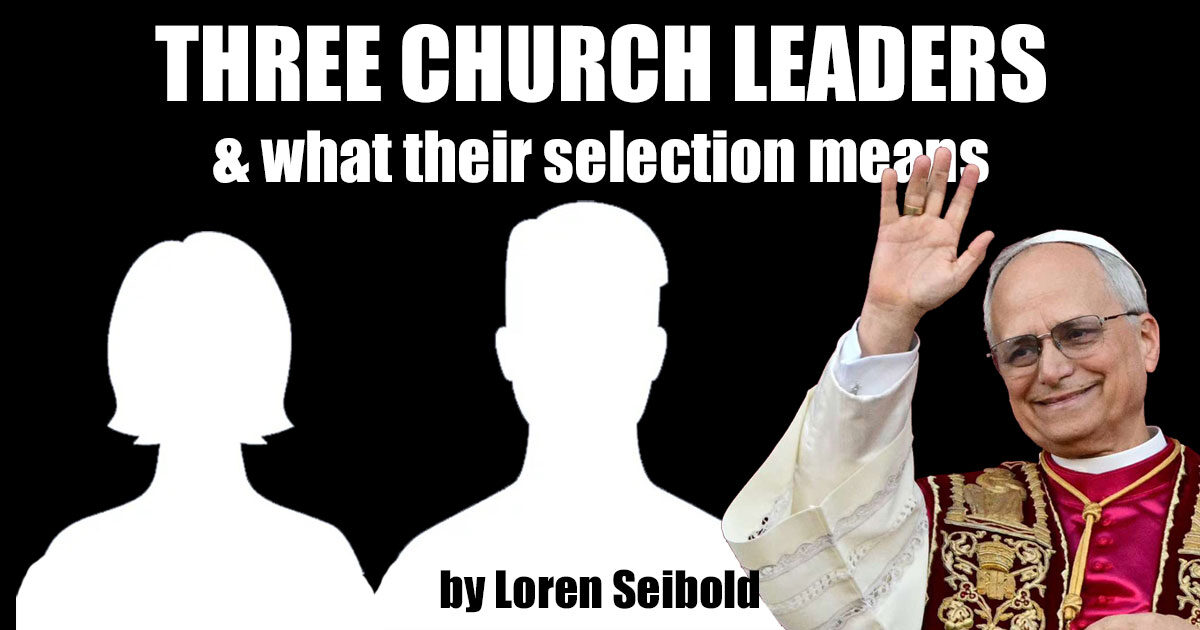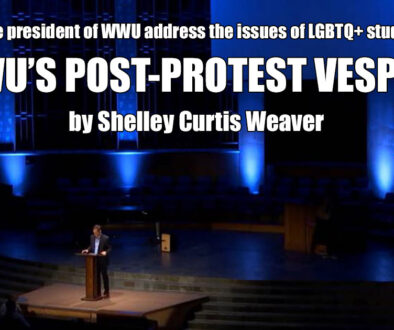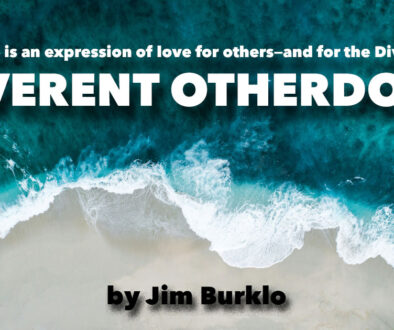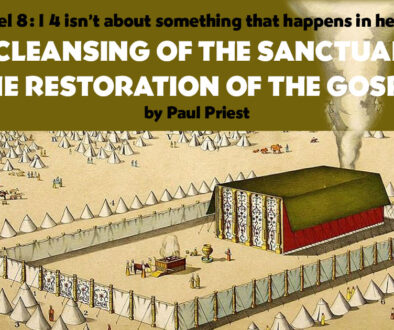Three Church Leaders, & What Their Selection Means
by Loren Seibold | 9 May 2025 |
Three religious bodies are choosing their leaders in about the same six-month period. Two of them are major world communions; the other imagines it is. Two of the leaders will have worldwide name recognition; the third will be known only to his own church of roughly 20,000,000 members.
Yet that one—ours—has perhaps the highest opinion of itself, and publicly cultivates an unfavorable opinion of the others.
The Roman Catholic Church
As of yesterday, May 8, Cardinal Robert Francis Prevost is Pope Leo XIV.
There are only two firm qualifications to be a pope: that he be Roman Catholic, and male. (It is not a qualification that a pope be a clergyman, though for the last 1,000 years all of them have been.) The pope is selected by a group of top church leaders, the College of Cardinals—in this convocation, 133 of them. They meet in secret, and vote until a nominee gets two-thirds of the votes, at which point they send white smoke up a chimney to signal that they’ve done their job.
Chosen names sometimes define aspirations. Leo XIV’s 19th-century namesake, Pope Leo XIII, is remembered as the pope of the industrial revolution: the “workers’ pope.” In 1891 Leo XIII wrote an encyclical in which he affirmed the rights of workers to a fair wage, to form trade unions, and to demand safe working conditions. He opposed both socialism and laissez-faire capitalism, and was sympathetic to the poor.
(An earlier Leo, Leo X, was the pope for whom Tetzel sold indulgences, and who excommunicated Martin Luther.)
Early reports say that Prevost is a centrist in the mode of Francis: he opposes female clergy and married clergy, but has enough experience in the mission field—Peru—to also be deeply devoted to poor and working people.
He’s also the first United States-born pope—a Chicago boy. This could be a boost to Roman Catholicism here.
It will also be a nice boost for Adventist evangelists, who raise money off of such spectacles.
The Anglican Communion
Instead of a pope, the Anglican Communion has the Archbishop of Canterbury—technically the senior bishop of the Church of England, though he holds status in worldwide Anglicanism. He is less of a final authority than the pope: he is described as primus inter pares: “first among equals” among all Anglican bishops worldwide.
The Anglican Communion includes not just the Church of England, but churches that are part of the Anglican tradition around the world. Here in the United States, the Anglican church was renamed the Episcopal Church following the American Revolution, at a time when it wasn’t politically popular to be beholden to England in any way. But the Episcopal Church is nonetheless part of the Anglican Communion, even if not under the direct authority of the Archbishop of Canterbury.
The Church of England hasn’t as large a membership as the Roman Catholic Church, but it is extremely influential. For one thing, King Charles III of England is its titular head. What I find admirable is that the church has made clear its desire to be a broad church: it includes high church Anglicans who out-Catholic the Catholics in their worship: evangelicals such as the late John R.W. Stott, and even a smattering of charismatics—all coexisting in one fellowship.
Back in January Justin Welby, the latest Archbishop of Canterbury, stepped down from that post. Unlike the Roman Catholic Church, the Anglican Communion has dawdled over their selection of a replacement. For one thing, they start with a detailed study, a “Statement of Needs,” to assess the needs of both the Canterbury diocese and the entire Anglican Communion. They also have broader selection criteria than the Roman Catholic Church does: for example, of the seven top candidates, four are women.
Since the Archbishop of Canterbury is not the “big boss” of his or her church in the same way that the pope is in Roman Catholicism, it may not matter as much if the position remains open for awhile. He is not just a figurehead—but his authority does appear largely based on influence rather than chain of command.
The Crowns Nomination Commission (17 voting members, 11 of whom can be laypeople, and that includes a lay chair) makes the selection of top candidates. From there the process moves to a level that would give us Adventists a high-altitude headache: the Commission sends two names to the prime minister of England, who selects one of them to send to King Charles, who in turn gives the Canterbury College of Canons permission to elect that person as the new Archbishop.
The Seventh-day Adventist Church
We, too, have a leadership selection to make this year. We don’t use the title “pope” (from the Greek pappas, meaning father), or the biblical word “bishop” (episcopas). (Though it is a fact that Ted Wilson’s father, Neal C. Wilson, once claimed the title of “first minister” for the office of the General Conference (GC) president in order to make the case that the General Conference had the authority to deny women equal pay for equal work at Pacific Press.)
While both of these churches have a monarchical history, ours is said to be democratic. Democracies, though, have tremendous flexibility in how they represent people’s hopes and needs. If there is politics in the selection processes of the Roman Catholic Church and the Anglican Communion, there is just as much in ours, starting with the selection of the delegates and subcommittees, and how the meeting is run. A bossy chair can stand to the podium and tell delegates how he prefers them to vote, as Ted Wilson did with women’s ordination in 2015.
One thing we have in common with Roman Catholics is that candidates for GC president must be male and clergy. In recent years they’ve also been expected to have served outside of North America, though no one with dark skin has ever been elected to that office.
Another way in which we are quite like the Roman Catholic Church is the way we select our president. Though we call our College of Cardinals a “nominating committee,” it is made up mostly of church administrators, with a token contingent of compliant lay people. We don’t bother with an assessment of needs like the Anglicans, because the nominating committee is chosen and meets at the beginning of the session and is under pressure to crank out a nominee quickly.
This means that potential nominating committee members have to already have a pretty good idea of who the top three or four candidates are. Occasionally there has been a dark horse: Robert Folkenberg was a surprise selection in 1990, though the church may have had reason to regret that choice when Folkenberg was charged with ethical violations, hit with lawsuits, and forced to resign.
In any case, the selection of a GC president is hardly a shining “voice of the people” moment: the nominating committee selects him, and the delegates will inevitably vote in whomever they select.
There is another way that we are very much like the Roman Catholics: like them, we say that we are God’s only true church on earth. While the Anglican Communion appears generous in embracing differences, the most devoted Adventists deny that anyone other than ourselves knows the mind of God. We often quote The Great Controversy, accusing the papacy of arrogance and overreach—but it could be argued that even that church has been more generous than ours in acknowledging and accepting other followers of Jesus Christ.
What happens now
Roman Catholicism is historically the bête noire of the Adventist Church, which has historically meant that anything that happens in their church makes more news among us than what happens in our own. Adventist figures who have little to offer in terms of thoughtful spirituality are right now rolling in conspiracies about the new American pope like pigs in muck—and like said pigs, enjoying it tremendously.
It is, it must be said, their own muck that they’re rolling in. The pope, if he even knows who we are, has no intention of forcing us to give up Sabbath worship. This is imaginary stuff—though profitable for those who are raising money off of it. It is a sad commentary on contemporary Adventism that many of us are more obsessed with imaginary enemies than with Jesus as our savior and example.
Whoever our new General Conference president is, he will have to join the pigs in the anti-Catholic muck if he is to succeed. It is what we do, and he will do it. I see no end to this church’s obsession with Roman Catholics as long as The Great Controversy is effectively more important than the Bible, and the actual needs of the world are ignored in favor of imaginary prophecies.
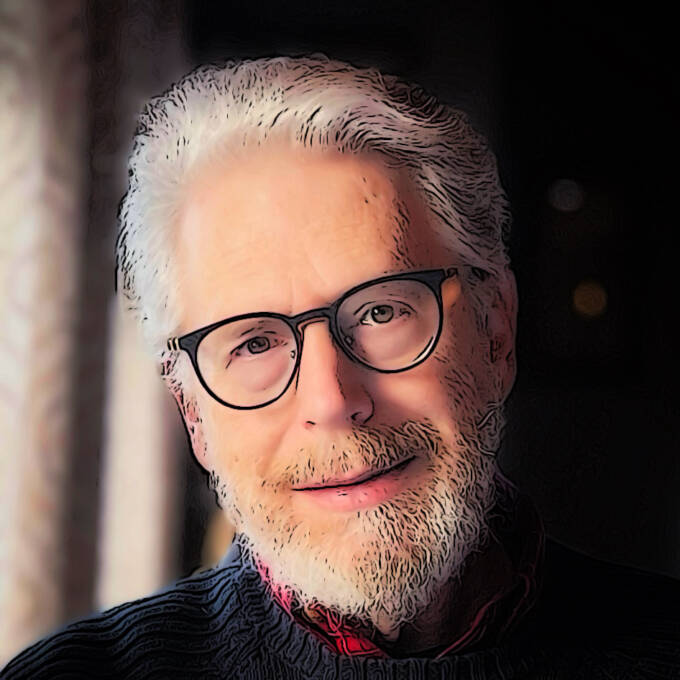 Loren Seibold is the executive editor of Adventist Today.
Loren Seibold is the executive editor of Adventist Today.

